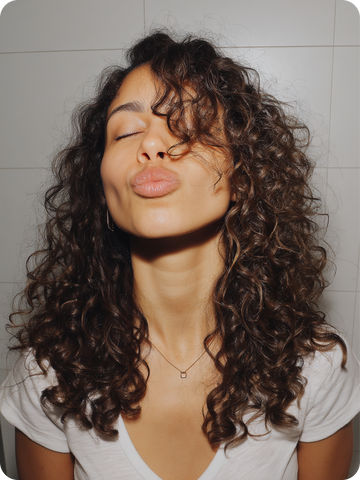How can a towel make curls firmer and curl care more comfortable? You'll find out in this article - today we're going to talk about plopping!
How does that word translate to “curly”?
Plopping is a technique that tells the curl its natural shape and helps the curl memorize it.
Plopping can be used to:
- remove excess moisture and styling
- Form elastic curls (hair will not stretch under the weight of water💧)
- speed up curl drying
- make the process of drying hair more comfortable and multitask ⚡️ (you will have time to do a face mask or other care procedures, while the hair will “flop” and will not interfere with you!)
So how do you do this mysterious plopping?
There are two main types: classic and microplopping. Let's look at each one in more detail ⤵️
1. Classic
It's perfect for relaxed big curls and waves that stretch easily under the weight of the water!

Step 1: Spread a microfiber towel or plopping hood on a flat surface and lower your head onto the fabric. Make sure that the curls are properly sprung. Moisturized hair will gather on the parietal like an accordion and take a natural shape
Step 2: Take the edges of the fabric on the right and left side of the head and pull them upwards.
Step 3. Intercept the towel or hood from behind at the base of the neck and twist into a tourniquet.
Step 4. Secure the tourniquet with a crab at the top of the head or, in the case of a hood, fasten the loop in the forehead area (very handy!).
Step 5. Remove the towel after 5-10 minutes and enjoy the moisturized spirals
❗️Important❗️
- Classic plopping is best not done for more than 15 minutes, because the longer you leave your curls in the towel, the less product and moisture you will get out.
- If you apply styling first and then do a classic plopping, be aware that the scalp may react negatively to the fixative.
- Classic plopping may not be suitable for very plastic and soft hair that can be easily deformed, or for short haircuts. But that doesn't mean you should immediately throw away all towels and hoods! After all, there are...⤵️
2. Microplopping
It can be used to quickly and easily remove excess moisture and styling from the hair. This way the curls will not straighten under their own weight🌀
This type of plopping is suitable for all hair structures and all curl types 🔥

All you have to do is gently press and blot your hair with a microfiber towel. The cloth will absorb all the excess, but will not dry out the curls and will retain the right amount of moisture.
❗️ To keep your curls in shape after plopping, try not to touch them until they are completely dry. ❗️
Quality plopping will not be achieved if you use a towel made of the wrong fabric. How then to choose the right textile?
During plopping, moisture from the products is absorbed into the pile - the rate of absorption depends on the material of your towel or hoodie.
Remember one of the main rules of CGM is to avoid cotton fabric. Cotton absorbs moisture very quickly, and our job is to keep it in our hair.
The optimal choice is microfiber with a short pile. Such a material will not absorb a large amount of water and products, and will not traumatize the cuticle.
A really good towel will have the following characteristics:
- Short pile, no more than 3 mm.The longer the pile, the stronger and faster it absorbs water. And to form delineated curls without fluff, you should try to keep moisture in them as much as possible.
- Knitted weave:Regularly woven towels are coarse and do not stretch, making plopping uncomfortable. A knitted weave can solve these problems.
- Thedenserthe fabric, the more water it absorbs. Anything above 340g is very drying to the hair and stimulates the formation of frizz.

By doing plopping with the right textile and following all the rules, you will get bouncy outlined and plumped curls without excess frizz😍
